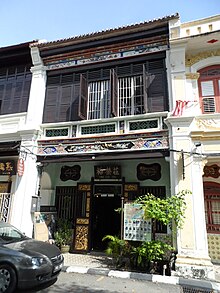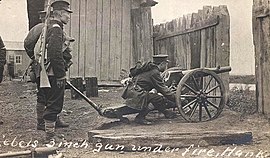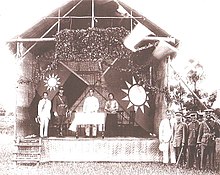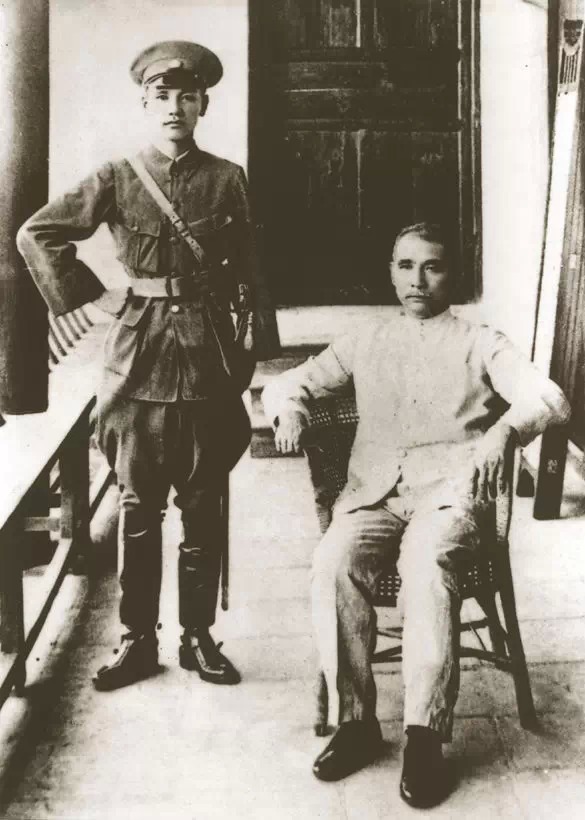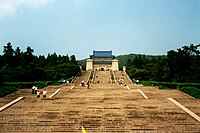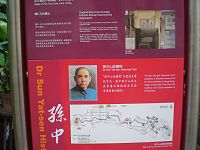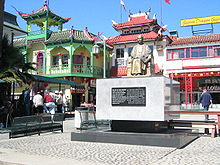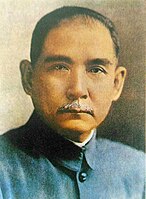
Overview
Sun Yat-sen (12 November 1866 12 March 1925) was a Chinese physician , writer, philosopher, calligrapher and revolutionary, the first president and founding father of the Republic of China. As the foremost pioneer of the Republic of China, Sun is referred to as the “Father of the Nation” in the Republic of China (ROC), Hong Kong,Macau and the “forerunner of democratic revolution” in People’s Republic of China (PRC). Sun played an instrumental role in the overthrow of the Qing dynasty during the years leading up to the Xinhai Revolution. He was appointed to serve as Provisional President of the Republic of China when it was founded in 1912. He later co-founded the Nationalist Party of China, serving as its first leader. Sun was a uniting figure in post-Imperial China, and he remains unique among 20th-century Chinese politicians for being widely revered amongst the people from both sides of the Taiwan Strait.
Although Sun is considered to be one of the greatest leaders of modern China, his political life was one of constant struggle and frequent exile. After the success of the revolution, he quickly resigned from his post as President of the newly founded Republic of China due to Beiyang Clique pressure, and led successive revolutionary governments as a challenge to the warlords who controlled much of the nation. Sun did not live to see his party consolidate its power over the country during the Northern Expedition. His party, which formed a fragile alliance with the Communists, split into two factions after his death.
Sun’s chief legacy resides in his developing of the political philosophy known as the Three Principles of the People: nationalism (non-ethnic, independence from imperialist domination), democracy, and the people’s livelihood (free trade and modern tax reform).
Names
Sun was born as Sun Wen and his genealogical name was Sun Deming As a child, his pet name was Dixiang Sun’s courtesy name was Zaizhi , and his baptized name was Rixin . While at school in Hong Kong he got the art name Yat-sen .S?n Zh?ngsh?n , the most popular of his Chinese names, is derived from his Japanese name Nakayama Sh, the pseudonym given to him by Titen Miyazaki while in hiding in Japan.
Early years
Birthplace and early life
Sun Yat-sen was born on 12 November 1866. His birthplace was the village of Cuiheng, Xiangshan County (now Zhongshan City), Guangdong Province. He had a cultural background of Hakka and Cantonese. After finishing primary education, he moved to Honolulu in the Kingdom of Hawaii, where he lived a comfortable life of modest wealth supported by his elder brother Sun Mei.
Education years
At the age of 10, Sun Yat-sen began seeking schooling. It is also at this point where he met childhood friend Lu Haodong. By age 13 in 1878 after receiving a few years of local schooling, Sun went to live with his elder brother, Sun Mei in Honolulu. Sun Mei financed Sun Yat-sen’s education and would later be the major contributor for the overthrow of the Manchus.
Sun Yat-sen then studied at ?Iolani School where he learned English, British history, mathematics, science, and Christianity. Originally unable to speak the English language, Sun Yat-sen picked up the language so quickly that he received a prize for outstanding achievement from King David Kalkaua. Sun graduated from Iolani in 1882. He then attended Oahu College (now known as Punahou School) for one semester. In 1883 he was soon sent home to China as his brother was becoming afraid that Sun Yat-sen would embrace Christianity.
When he returned home in 1883 at age 17, Sun met up with his childhood friend Lu Haodong at Beijidian , a temple in Cuiheng Village. They saw many villagers worshipping the Beiji (literally North Pole) Emperor-God in the temple, and were dissatisfied with their ancient healing methods. They broke the statue, incurring the wrath of fellow villagers, and escaped to Hong Kong. While in Hong Kong in 1883 he studied at the Diocesan Boys’ School, and from 1884 to 1886 he was at The Government Central School.
In 1886 Sun studied medicine at the Guangzhou Boji Hospital under the Christian missionary John G. Kerr. Ultimately, he earned the license of Christian practice as a medical doctor from the Hong Kong College of Medicine for Chinese (the forerunner of The University of Hong Kong) in 1892. Notably, of his class of 12 students, Sun was one of only two who graduated.
Religious views and Christian baptism
In the early 1880s, Sun Mei sent his brother to ?Iolani School, which was under the supervision of British Anglicans and directed by an Anglican prelate called Alfred Willis. The language of instruction was English. Although Bishop Willis emphasized that no one was forced to accept Christianity, the students were required to attend chapel on Sunday. At Iolani School, young Sun Wen first came in contact with Christianity, and it made a deep impression on him. Schriffin writes that Christianity was to have a great influence on Sun’s whole future political life.
Sun was later baptized in Hong Kong by an American missionary of the Congregational Church of the United States to his brother’s disdain. The minister would also develop a friendship with Sun. Sun attended To Tsai Church , founded by the London Missionary Society in 1888, while he studied Western Medicine in Hong Kong College of Medicine for Chinese. Sun pictured a revolution as similar to the salvation mission of the Christian church. His conversion to Christianity was related to his revolutionary ideals and push for advancement.
Transformation into a revolutionary
Photograph of Sun Yat-sen (seated, second from left) and his revolutionary friends, the Four Bandits, including Yeung Hok-ling (left), Chan Siu-bak (seated, second from right), Yau Lit (right), and Guan Jingliang (standing) at the Hong Kong College of Medicine for Chinese
Four Bandits
During the Qing Dynasty rebellion around 1888, Sun was in Hong Kong with a group of revolutionary thinkers who were nicknamed the Four Bandits at the Hong Kong College of Medicine for Chinese. Sun, who had grown increasingly frustrated by the conservative Qing government and its refusal to adopt knowledge from the more technologically advanced Western nations, quit his medical practice in order to devote his time to transforming China.
Furen and Revive China Society
In 1891, Sun met revolutionary friends in Hong Kong including Yeung Ku-wan who was the leader and founder of the Furen Literary Society. The group was spreading the idea of overthrowing the Qing. In 1894, Sun wrote an 8,000 character petition to Qing Viceroy Li Hongzhang presenting his ideas for modernizing China. He traveled to Tianjin to personally present the petition to Li but was not granted an audience. After this experience, Sun turned irrevocably toward revolution. He left China for Hawaii and founded the Revive China Society, which was committed to revolutionizing China’s prosperity. Members were drawn mainly from Chinese expatriates, especially the lower social classes. The same month in 1894 the Furen Literary Society was merged with the Hong Kong chapter of the Revive China Society. Thereafter, Sun became the secretary of the newly merged Revive China society, which Yeung Ku-wan headed as president. They disguised their activities in Hong Kong under the running of a business under the name “Kuen Hang Club”.
First Sino-Japanese War
In 1895, China suffered a serious defeat during the First Sino-Japanese War. There were two types of responses. One group of intellectuals contended that the Manchu Qing government could restore its legitimacy by successfully modernizing. Stressing that overthrowing the Manchu would result in chaos and would lead to China being carved up by imperialists, intellectuals like Kang Youwei and Liang Qichao supported responding with initiatives like the Hundred Days’ Reform. In another faction, Sun Yat-sen and others like Zou Rong wanted a revolution to replace the dynastic system with a modern nation-state in the form of a republic. The Hundred Days’ reform turned out to be a failure by 1898.
From uprising to exile
Letter from Sun Yat-sen to James Cantlie announcing to him that he has assumed the Presidency of the Provisional Republican Government of China. Dated 21 January 1912.
First Guangzhou uprising
In the second year of the establishment of the Revive China society on 26 October 1895, the group planned and launched the First Guangzhou uprising against the Qing in Guangzhou.Yeung Kui-wan directed the uprising starting from Hong Kong. However, plans were leaked out and more than 70 members, including Lu Haodong, were captured by the Qing government. The uprising was a failure. Sun received financial support mostly from his brother who sold most of his 12,000 acres of ranch and cattle in Hawaii. Additionally, members of his family and relatives of the Sun would take refuge at the home of his brother Sun Mei at Kamaole in Kula, Maui.
Exile in Japan
Sun Yat-sen spent time living in Japan while in exile. He befriended and was financially aided by a democratic revolutionary named Miyazaki Toten. Most Japanese who actively worked with Sun were motivated by a pan-Asian fear of encroaching Western imperialism. While in Japan, Sun also met and befriended Mariano Ponce, then a diplomat of the First Philippine Republic. During the Philippine Revolution and the PhilippineAmerican War, Sun helped Ponce procure weapons salvaged from the Imperial Japanese Army and ship the weapons to the Philippines. By helping the Philippine Republic, Sun hoped that the Filipinos would win their independence so that he could use the archipelago as a staging point of another revolution. However, as the war ended in July 1902, America emerged victorious from a bitter 3-year war against the Republic. Therefore, the Filipino dream of independence vanished with Sun’s hopes of collaborating with the Philippines in his revolution in China.
Huizhou uprising in China
On 22 October 1900, Sun launched the Huizhou uprising to attack Huizhou and provincial authorities in Guangdong. This came five years after the failed Guangzhou uprising. This time, Sun appealed to the triads for help. This uprising was also a failure. Miyazaki who participated in the revolt with Sun wrote an account of this revolutionary effort under the title “33-year dream” in 1902.
Further exile
Sun was in exile not only in Japan but also in Europe, the United States, and Canada. He raised money for his revolutionary party and to support uprisings in China. In 1896 he was detained at the Chinese Legation in London, where the Chinese Imperial secret service planned to kill him. He was released after 12 days through the efforts of James Cantlie, The Globe, The Times, and the Foreign Office, leaving Sun a hero in Britain. James Cantlie, Sun’s former teacher at the Hong Kong College of Medicine for Chinese, maintained a lifelong friendship with Sun and would later write an early biography of Sun.
Heaven and Earth Society, overseas travel
A “Heaven and Earth Society” sect known as Tiandihui had been around for a long time. The group has also been referred to as the “three cooperating organizations” as well as the triads. Sun Yat-sen mainly used this group to leverage his overseas travels to gain further financial and resource support for his revolution.
According to Lee Yun-ping, chairman of the Chinese historical society, Sun needed a certificate to enter the United States at a time when the Chinese Exclusion Act of 1882 would have otherwise blocked him. However, on Sun’s first attempt to enter the US, he was still arrested. He was later bailed out after 17 days. In March 1904, while residing in Kula, Maui, Sun Yat-sen obtained a Certificate of Hawaiian Birth, issued by the Territory of Hawaii, stating that “he was born in the Hawaiian Islands on the 24th day of November, A.D. 1870.” He renounced it after it served its purpose to circumvent the Chinese Exclusion Act of 1882. Official files of the United States show that Sun had United States nationality, moved to China with his family at age 4, and returned to Hawaii 10 years later.
Revolution
Tongmenghui
In 1904, Sun Yat-sen came about with the goal “to expel the Tatar barbarians (i.e. Manchu), to revive Zhonghua, to establish a Republic, and to distribute land equally among the people” . One of Sun’s major legacies was the creation of his political philosophy of the Three Principles of the People. These Principles included the principle of nationalism (minzu), of democracy (minquan ), and of welfare (minsheng).
On 20 August 1905, Sun joined forces with revolutionary Chinese students studying in Tokyo, Japan to form the unified group Tongmenghui (United League), which sponsored uprisings in China. By 1906 the number of Tongmenghui members reached 963 people.
Interior of the Wan Qing Yuan featuring Sun’s items and photos
Malaya support
The Sun Yat-sen Museum in George Town, Penang, Malaysia, where he planned the Xinhai Revolution.
Sun’s notability and popularity extends beyond the Greater China region, particularly to Nanyang (Southeast Asia), where a large concentration of overseas Chinese resided in Malaya (Malaysia and Singapore). While in Singapore, he met local Chinese merchants Teo Eng Hock, Tan Chor Nam and Lim Nee Soon, which mark the commencement of direct support from the Nanyang Chinese. The Singapore chapter of the Tongmenghui was established on 6 April 1906. Though some records claim the founding date to be end of 1905. The villa used by Sun was known as Wan Qing Yuan. At this point Singapore was the headquarters of the Tongmenghui.
Thus, after founding the Tong Meng Hui, Dr Sun advocated the establishment of The Chong Shing Yit Pao as the alliance’s mouthpiece to promote revolutionary ideas. Later, he initiated the establishment of reading clubs across Singapore and Malaysia, in order to disseminate revolutionary ideas among the lower class through public readings of newspaper stories. The United Chinese Library, founded on 8 August 1910, was one such reading club, first set up at leased property on the second floor of the Wan He Salt Traders in North Boat Quay.
The first actual United Chinese Library building was built between 1908 and 1911 below Fort Canning – 51 Armenian Street, commenced operations in 1912. The library was set up as a part of the 50 reading rooms by the Chinese Republicans to serve as an information station and liaison point for the revolutionaries. In 1987, the library was moved to its present site at Cantonment Road. But the Armenian Street building is still intact with the plaque at its entrance with Sun Yat Sen’s words. With an initial membership of over 400, the library has about 180 members today. Although the United Chinese Library, with 102 years of history, was not the only reading club in Singapore during the time, today it is the only one of its kind remaining.
Siamese support
In 1903, Dr. Sun made a secret trip to Bangkok in which he sought funds for his cause in Southeast Asia. His loyal followers published newspapers, providing invaluable support to the dissemination of his revolutionary principles and ideals among Chinese descant in Thailand. In Bangkok, Sun visited Yaowarat Road, in Bangkok’s Chinatown. It was on this street that Sun gave a speech claiming that overseas Chinese were the Mother of the Revolution. He also met local Chinese merchants Seow Houtseng, whose sent financial support to him.
Sun’s speech on Yaowarat street was commemorated by the street later being named “Sun Yat Sen Street” or “Soi Sun Yat Sen” in his honour.
Zhennanguan uprising
On 1 December 1907, Sun led the Zhennanguan uprising against the Qing at Friendship Pass, which is the border between Guangxi and Vietnam. The uprising failed after seven days of fighting. In 1907 there were a total of four uprisings that failed including Huanggang uprising, Huizhou seven women lake uprising and Qinzhou uprising. In 1908 two more uprisings failed one after another including Qin-lian uprising and Hekou uprising.
Anti-Sun movements
Because of these failures, Sun’s leadership was challenged by elements from within the Tongmenghui who wished to remove him as leader. In Tokyo 1907-1908 members from the recently merged Restoration society raised doubts about Sun’s credentials. Tao Chengzhang and Zhang Binglin publicly denounced Sun with an open leaflet called “A declaration of Sun Yat-sen’s criminal acts by the revolutionaries in Southeast Asia”. This was printed and distributed in reformist newspapers like Nanyang Zonghui Bao. Their goal was to target Sun as a leader leading a revolt for profiteering gains.
The revolutionaries were polarized and split between pro-Sun and anti-Sun camps. Sun publicly fought off comments about how he had something to gain financially from the revolution. However, by 19 July 1910, the Tongmenghui headquarters had to relocate from Singapore to Penang to reduce the anti-Sun activities. It is also in Penang that Sun and his supporters would launch the first Chinese “daily” newspaper, the Kwong Wah Yit Poh in December 1910.
1911 revolution
The Revolutionary Army of the Wuchang Uprising fighting in the Battle of Yangxia
To sponsor more uprisings, Sun made a personal plea for financial aid at the Penang conference held on 13 November 1910 in Malaya. The leaders launched a major drive for donations across the Malay Peninsula. They raised HK$187,000.
On 27 April 1911, revolutionary Huang Xing led a second Guangzhou uprising known as the Yellow Flower Mound revolt against the Qing. The revolt failed and ended in disaster; the bodies of only 72 revolutionaries were found. The revolutionaries are remembered as martyrs.
On 10 October 1911, a military uprising at Wuchang took place led again by Huang Xing. At the time, Sun had no direct involvement as he was still in exile. Huang was in charge of the revolution that ended over 2000 years of imperial rule in China. When Sun learned of the successful rebellion against the Qing emperor from press reports, he returned to China from the United States accompanied by his closest foreign advisor, the American, “General” Homer Lea. He met Lea in London, where he and Lea unsuccessfully tried to arrange British financing for the new Chinese republic. Sun and Lea then sailed for China, arriving there on 21 December 1911.
The uprising expanded to the Xinhai Revolution also known as the “Chinese Revolution” to overthrow the last Emperor Puyi. After this event, 10 October became known as the commemoration of Double Ten Day.
Republic of China with many governments
Provisional government
On 29 December 1911 a meeting of representatives from provinces in Nanking (Nanjing) elected Sun Yat-sen as the “provisional president” . January 1, 1912 was set as the first day of the First Year of the Republic.Li Yuanhong was made provisional vice-president and Huang Xing became the minister of the army. The new Provisional Government of the Republic of China was created along with the Provisional Constitution of the Republic of China. Sun is credited for the funding of the revolutions and for keeping the spirit of revolution alive, even after a series of failed uprisings. His successful merger of minor revolutionary groups to a single larger party provided a better base for all those who shared the same ideals. A number of things were introduced such as the republic calendar system and new fashion like Zhongshan suits.
Beiyang government
Yuan Shikai, who controlled the Beiyang Army, the military of northern China, was promised the position of President of the Republic of China if he could get the Qing court to abdicate. On 12 February 1912 Emperor Puyi did abdicate the throne. Sun stepped down as President, and Yuan became the new provisional president in Beijing on 10 March 1912. The provisional government did not have any military forces of its own, its control over elements of the New Army that had mutinied was limited and there were still significant forces which still had not declared against the Qing.
Sun Yat-sen sent telegrams to the leaders of all provinces requesting them to elect and to establish the National Assembly of the Republic of China in 1912. In May 1912 the legislative assembly moved from Nanjing to Beijing with its 120 members divided between members of Tongmenghui and a Republican party that supported Yuan Shikai. Many revolutionary members were already alarmed by Yuan’s ambitions and the northern based Beiyang government.
Nationalist party and Second Revolution
Tongmenghui member Song Jiaoren quickly tried to control the parliament. He mobilized the old Tongmenghui at the core with the merger of a number of new small parties to form a new political party called the Kuomintang (Chinese nationalist party, commonly abbreviated as “KMT”) on 25 August 1912 at Huguang Guild Hall Beijing. The 19121913 National assembly election was considered a huge success for the KMT winning 269 of the 596 seats in the lower house and 123 of the 274 senate seats. The Second Revolution took place where Sun and KMT military forces tried to overthrow Yuan’s forces of about 80,000 men in an armed conflict in July 1913. The revolt against Yuan was unsuccessful. Sun was forced to seek asylum in Japan with politician and industrialist Fusanosuke Kuhara. In retaliation the national party leader Song Jiaoren was assassinated, almost certainly by a secret order of Yuan, on 20 March 1913.
Political chaos
In 1915 Yuan Shikai proclaimed the Empire of China (19151916) with himself as Emperor of China. Sun took part in the Anti-Monarchy war of the Constitutional Protection Movement, while also supporting bandit leaders like Bai Lang during the Bai Lang Rebellion. This marked the beginning of the Warlord Era. In 1915 Sun wrote to the Second International, a socialist-based organization in Paris, asking it to send a team of specialists to help China set up the world’s first socialist republic. At the time there were many theories and proposals of what China could be. In the political mess, both Sun Yat-sen and Xu Shichang were announced as President of the Republic of China.
Path to Northern Expedition
(L-R): Liao Zhongkai, Chiang Kai-shek, Sun Yat-sen and Soong Ching-ling at the founding of the Whampoa Military Academy in 1924
Guangzhou militarist government
China had become divided between different military leaders without a proper central government. Sun saw the danger of this and returned to China in 1917 to advocate Chinese reunification. In 1921 he started a self-proclaimed military government in Guangzhou and was elected Grand Marshal. Between 1912 and 1927 three governments had been set up in South China: the Provisional government in Nanjing (1912), the Military government in Guangzhou (19211925), and the National government in Guangzhou and later Wuhan (19251927). The southern separatist government in the South was established to rival the Beiyang government in the north. Yuan Shikai had banned the KMT. The short lived Chinese Revolutionary Party was a temporary replacement for the KMT. On 10 October 1919 Sun resurrected the KMT with the new name Chung-kuo Kuomintang or the “Nationalist Party of China”.
Sun Yat-sen (seated on right) and Chiang Kai-shek
KMTCPC cooperation
By this time Sun had become convinced that the only hope for a unified China lay in a military conquest from his base in the south, followed by a period of political tutelage that would culminate in the transition to democracy. In order to hasten the conquest of China, he began a policy of active cooperation with the Communist Party of China (CPC). Sun and the Soviet Union‘s Adolph Joffe signed the Sun-Joffe Manifesto in January 1923. Sun received help from the Comintern for his acceptance of communist members into his KMT. Revolutionary and socialist leader Vladimir Lenin praised Sun and the KMT for their ideology and principles. Lenin praised Sun and his attempts at social reformation, and also congratulated him for fighting foreign Imperialism. Sun also returned the praise, calling him a “great man”, and sent his congratulations on the revolution in Russia.
With the Soviets’ help, Sun was able to develop the military power needed for the Northern Expedition against the military at the north. He established the Whampoa Military Academy near Guangzhou with Chiang Kai-shek as the commandant of the National Revolutionary Army (NRA). Other Whampoa leaders include Wang Jingwei and Hu Hanmin as political instructors. This full collaboration was called the First United Front.
Finance concerns
In 1924 Sun appointed his brother-in-law T. V. Soong to set up the first Chinese Central bank called the Canton Central Bank. To establish national capitalism and a banking system was a major objective for the KMT. However Sun was not without some opposition as there was the Canton volunteers corps uprising against him.
Final speeches
Sun (seated, right) and his wife Soong Ching-ling (seated next to him) in Kobe, Japan in 1924
In February 1923 Sun made a presentation to the Students’ Union in Hong Kong University and declared that it was the corruption of China and the peace, order and good government of Hong Kong that turned him into a revolutionary. This same year, he delivered a speech in which he proclaimed his Three Principles of the People as the foundation of the country and the Five-Yuan Constitution as the guideline for the political system and bureaucracy. Part of the speech was made into the National Anthem of the Republic of China.
On 10 November 1924, Sun traveled north to Tianjin and delivered a speech to suggest a gathering for a “national conference” for the Chinese people. It called for the end of warlord rules and the abolition of all unequal treaties with the Western powers. Two days later, he traveled to Beijing to discuss the future of the country, despite his deteriorating health and the ongoing civil war of the warlords. Among the people he met was the Muslim General Ma Fuxiang, who informed Sun that they would welcome the leadership of Dr. Sun. On 28 November 1924 Sun traveled to Japan and gave a speech on Pan-Asianism at Kobe, Japan.
Illness and death
Assuming that they still exist, the original medical records and Autopsy Report relating to Dr. Sun’s illness and death could not be found in the files of the Department of Pathology at Peking Union Medical College Hospital (PUMCH). However, a copy of the Autopsy Report is preserved in the museum section of the Sun Yat-sen Memorial in Guangzhou, China. It had been widely believed and reported in both the Chinese and foreign press at the time of his death that Dr. Sun died of liver cancer. This was based on the exploratory laparotomy that was performed by Dr. Adrian Taylor, Head of the Department of Surgery at PUMCH, on January 26, 1925. Dr. Taylor found that Dr. Sun’s liver was extensively infiltrated with a malignant tumor and that it had spread to the abdominal organs and lungs. Based on this observation he concluded that Dr. Sun had liver cancer and that he only had a short time to live. On February 18, 1925, against the advice of his doctors, Dr. Sun was transferred to the former residence of Wellington Koo, who previously had been the Foreign Minister of the Republic of China. Despite the ministrations of “old style Chinese doctors” Dr. Sun became weaker and weaker, eventually refusing all food, and he died at the age of 58 on 12 March 1925. His body then was transported to the PUMCH and, with the reluctant agreement of his family, a limited autopsy was performed on March 13, 1925 by James R. Cash, M.D. Associate Professor in the Department of Pathology. Furthermore, Dr. Sun’s family had stipulated that no organs could be removed from his body, and apparently Dr. Cash was allowed to take only one tissue section, and that was of the tumor. Following the autopsy, “in the face of considerable opposition, the family had the courage to arrange for a Christian funeral service that was held in the beautiful auditorium of the PUMCH”. Following this the body then was “embalmed” (? preserved) in mineral oil and taken to the Temple of Azure Clouds, a Buddhist shrine in the Western Hills a few miles outside of Beijing. He also left a short political will (????) penned by Wang Jingwei, which had a widespread influence in the subsequent development of the Republic of China and Taiwan.
In 1926, construction began on a majestic mausoleum at the foot of Purple Mountain (Mount Zijin) in Nanjing, and this was completed in the Spring of 1929. On June 1, 1929, Dr. Sun’s remains were moved from Beijing and interred in the Sun Yat-sen Mausoleum.
However, as revealed in the recently discovered copy of Dr. Sun’s autopsy report, according to a brief clinical summary, Dr. Sun over ten years had had “digestive disturbances”. Several months before his admission to PUMCH, a mass was noted in his right upper abdomen, and by early 1925 this had become larger, causing him much discomfort and weakness. Significantly, however, he did not have fever, jaundice, or loss of weight. Based on the Autopsy Report, the true cause of Dr. Sun’s death was “an adenocarcinoma of the gallbladder with obstruction of the cystic duct; direct extension to liver and diaphragm; widespread metastasis to lungs, peritoneum, and small and large intestines.” In addition to his cancer, he had gallstones, which frequently can be associated with gallbladder cancer; moderate generalized atherosclerosis; pulmonary emphysema and edema; and healed tuberculosis of the lungs.
How then was it that in 2013 the popular press in China reported that Dr. Sun had died of gallbladder and not liver cancer? Most likely, it must have been based on Dr. Cash’s Autopsy Report, which probably had been on display for many decades, but no one ever really appreciated its significance until an American pathologist saw a barely legible document that turned out to be a copy of Dr. Sun’s Autopsy Report at the Sun Yat-sen Memorial in Guangzhou, China.
Legacy
Chinese Generals pay tribute to the Sun Yat-sen Mausoleum in Beijing in 1928 after the success of the Northern Expedition. From right to left, are Generals Cheng Jin , Zhang Zuobao , Chen Diaoyuan , Chiang Kai-shek, Woo Tsin-hang, Yan Xishan, Ma Fuxiang, Ma Sida , and Bai Chongxi.
Power struggle
After Sun’s death, a power struggle between his young protégé Chiang Kai-shek and his old revolutionary comrade Wang Jingwei split the KMT. At stake in this struggle was the right to lay claim to Sun’s ambiguous legacy. In 1927 Chiang Kai-shek married Soong Mei-ling, a sister of Sun’s widow Soong Ching-ling, and subsequently he could claim to be a brother-in-law of Sun. When the Communists and the Kuomintang split in 1927, marking the start of the Chinese Civil War, each group claimed to be his true heirs, a conflict that continued through World War II. Sun’s widow, Soong Ching-ling, sided with the Communists during the Chinese Civil War and served from 1949 to 1981 as Vice-President (or Vice-Chairwoman) of the People’s Republic of China and as Honorary President shortly before her death in 1981.
Cult of personality
A personality cult in the Republic of China was centered on Sun and his successor, Generalissimo Chiang Kai-shek. Chinese Muslim Generals and Imams participated in this cult of personality and one party state, with Muslim General Ma Bufang making people bow to Sun’s portrait and listen to the national anthem during a Tibetan and Mongol religious ceremony for the Qinghai Lake God. Quotes from the Quran and Hadith were used by Muslims to justify Chiang Kai-shek’s rule over China.
The Kuomintang’s constitution designated Sun as party president. After his death, the Kuomintang opted to keep that language in its constitution to honor his memory forever. The party has since been headed by a director-general (1927-1975) and a chairman (since 1975), which discharge the functions of the president.
Father of the Nation
Statue in the Mausoleum, Kuomintang flag on the ceiling
Sun Yat-sen remains unique among 20th-century Chinese leaders for having a high reputation both in mainland China and in Taiwan. In Taiwan, he is seen as the Father of the Republic of China, and is known by the posthumous name Father of the Nation, Mr. Sun Zhongshan ( where the one-character space is a traditional homage symbol). His likeness is still almost always found in ceremonial locations such as in front of legislatures and classrooms of public schools, from elementary to senior high school, and he continues to appear in new coinage and currency.
“Forerunner of the revolution”
On the mainland, Sun is seen as a Chinese nationalist and proto-socialist, and is highly regarded as the Forerunner of the Revolution . He is even mentioned by name in the preamble to the Constitution of the People’s Republic of China. In recent years, the leadership of the Communist Party of China has increasingly invoked Sun, partly as a way of bolstering Chinese nationalism in light of Chinese economic reform and partly to increase connections with supporters of the Kuomintang on Taiwan which the PRC sees as allies against Taiwan independence. Sun’s tomb was one of the first stops made by the leaders of both the Kuomintang and the People First Party on their pan-blue visit to mainland China in 2005. A massive portrait of Sun continues to appear in Tiananmen Square for May Day and National Day.
Religious veneration
Sun is venerated as a Saint , a religion established in Vietnam in 1926. He, along with the two other Saints Victor Hugo represented mankind to declare the Alliance (peaceful treaty) with God.
Family
Lu Muzhen (18671952), Sun’s first wife from 1885 to 1915
Sun Yat-sen was born to Sun Dacheng and his wife, lady Yang on 12 November 1866. At the time his father was age 53, while his mother was 38 years old. By the time he was born, he already had an older brother Sun Dezhang , an older sister Sun Jinxing who died at the early age of 4. Another older brother Sun Deyou also died at the age of 6. He had two other sisters Sun Miaoqian , who was older and Sun Qiuqi who was younger.
Sun had an arranged marriage with fellow villager Lu Muzhen at the age of 20. She bore him a son Sun Fo and two daughters, Sun Jinyuan and Sun Jinwan . Sun Fo was the grandfather of Leland Sun, who spent 37 years working in Hollywood as an actor and stuntman. Sun Yat-sen was also the godfather of Paul Myron Anthony Linebarger, American author and poet who wrote under the name Cordwainer Smith.
Sun subsequently married Soong Ching-ling, one of the Soong sisters. They were married in Japan on 25 October 1915.
Soong Ching-Ling’s father was the American-educated Methodist minister Charles Soong, who made a fortune in banking and printing of Bibles; though he had been a personal friend of Sun’s, he was enraged when Sun announced his intention to marry Ching-ling because Sun was himself a Christian yet kept two wives, Lu Muzhen and Kaoru Otsuki; Soong viewed Sun’s actions as running directly against their shared religion.
Soong Ching-Ling’s sister, Soong Mei-ling, later married Chiang Kai-shek.
Cultural references
Memorials and structures in Asia
The current NT$100 banknote design portraying Sun
In most major Chinese cities one of the main streets is named Zhongshan Lu to celebrate his memory. There are also numerous parks, schools, and geographical features named after him. Xiangshan, Sun’s hometown in Guangdong, was renamed Zhongshan in his honor, and there is a hall dedicated to his memory at the Temple of Azure Clouds in Beijing. There are also a series of Sun Yat-sen stamps.
Other references to Sun include the Sun Yat-sen University in Guangzhou and National Sun Yat-sen University in Kaohsiung. Other structures include Sun Yat-sen Mausoleum, Sun Yat-sen Memorial Hall subway station, Sun Yat-sen house in Nanjing, Dr. Sun Yat-sen Museum in Hong Kong, Chung-Shan Building, Sun Yat-sen Memorial Hall in Taipei and Sun Yat Sen Nanyang Memorial Hall in Singapore. Zhongshan Memorial Middle School has also been a name used by many schools. Zhongshan Park is also a common name used for a number of places named after him. The first highway in Taiwan is called the Sun Yat-sen expressway. Two ships are also named after him, the Chinese gunboat Chung Shan and Chinese cruiser Yat Sen. The old Chinatown in Calcutta (now known as Kolkata), India has a prominent street by the name of Sun Yat-sen street. There are also two streets named after Sun Yat-sen, located in the cities of Astrakhan and Ufa, Russia.
In George Town, Penang, Malaysia, the Penang Philomatic Union had its premises at 120 Armenian Street in 1910, during the time when Sun spent more than four months in Penang, convened the historic “Penang Conference” to launch the fundraising campaign for the Huanghuagang Uprising and founded the Kwong Wah Yit Poh; this house, which has been preserved as the Sun Yat-sen Museum (formerly called the Sun Yat Sen Penang Base), was visited by President designate Hu Jintao in 2002. The Penang Philomatic Union subsequently moved to a bungalow at 65 Macalister Road which has been preserved as the Sun Yat-sen Memorial Centre Penang.
As dedication, the 1966 Chinese Cultural Renaissance was launched on Sun’s birthday on 12 November.
The Nanyang Wan Qing Yuan in Singapore have since been preserved and renamed as the Sun Yat Sen Nanyang Memorial Hall. A Sun Yat-sen heritage trail was also launched on 20 November 2010 in Penang.
Sun’s US citizen Hawaii birth certificate that show he was not born in the ROC, but instead born in the US was on public display at the American Institute in Taiwan on US Independence day 4 July 2011.
A street in Medan, Indonesia is named “Jalan Sun Yat-Sen” in honour of him.
-
Sun Yat-sen Memorial Centre, George Town, Penang, Malaysia
-
A marker on the Sun Yat-sen Historical Trail on Hong Kong Island
Memorials and structures outside of Asia
St. John’s University in New York City has a facility built in 1973, the Sun Yat-Sen Memorial Hall, built to resemble a traditional Chinese building in honor of Dr. Sun.Dr. Sun Yat-Sen Classical Chinese Garden is located in Vancouver, the largest classical Chinese gardens outside of Asia. There is the Dr. Sun Yat-sen Memorial Park in Chinatown, Honolulu. On the island of Maui, there is the little Sun Yat-sen Park at Kamaole. It is located near to where his older brother had a ranch on the slopes of Haleakala in the Kula region.
In Chinatown, Los Angeles, there is a seated statue of him in Central Plaza. In Sacramento, California there is a bronze statue of Sun in front of the Chinese Benevolent Association of Sacramento. Another statue of Sun Yat-sen by Joe Rosenthal can be found at Riverdale Park in Toronto, Ontario, Canada. There is also the Moscow Sun Yat-sen University. In Chinatown, San Francisco, there is a 12-foot statue of him on St. Mary’s Square.
In late 2011, the Chinese Youth Society of Melbourne, in celebration of the 100th anniversary of the founding of the Republic Of China, unveiled, in a Lion Dance Blessing ceremony, a memorial statue of Dr. Sun Yat-Sen outside the Chinese Museum in Melbourne’s Chinatown, on the spot where their traditional Chinese New Year Lion Dance always ends.
In 1993 Lily Sun, one of Sun Yat-sen’s granddaughters, donated books, photographs, artwork and other memorabilia to the Kapi`olani Community College library as part of the “Sun Yat-sen Asian collection”. During October and November every year the entire collection is shown. In 1997 the “Dr Sun Yat-sen Hawaii foundation” was formed online as a virtual library. In 2006 the NASA Mars Exploration Rover Spirit labeled one of the hills explored “Zhongshan”.
The plaque shown earlier in this article is by Dora Gordine, and is situated on the site of Sun’s lodgings in London in 1896, 8 Grays Inn Place. There is also a blue plaque commemorating Sun at The Kennels, Cottered, Hertfordshire, the country home of the Cantlies where Sun came to recuperate after his rescue from the legation in 1896.
A street named Sun Yat-Sen Avenue is located in Markham. This is the first such street name outside of Asia.
In popular culture
Sun Yat-sen tribute in Tiananmen Square, 2010
Opera
Dr. Sun Yat-sen (????; Zh?ngSh?n yì xi?n) is a 2011 Chinese-language western-style opera in three acts by the New York-based American composer Huang Ruo who was born in China and is a graduate of Oberlin College’s Conservatory as well as the Juilliard School. The libretto was written by Candace Mui-ngam Chong, a recent collaborator with playwright David Henry Hwang. It was performed in Hong Kong in October 2011 and will be given its North American premiere on 26 July 2014 at The Santa Fe Opera.
TV series and films
The life of Sun is portrayed in various films, mainly The Soong Sisters and Road to Dawn. A fictionalized assassination attempt on his life was featured in Bodyguards and Assassins. He is also portrayed during his struggle to overthrow the Qing dynasty in Once Upon a Time in China II. The TV series Towards the Republic features Ma Shaohua as Sun Yat-sen. In the 100th anniversary tribute of the film 1911, Winston Chao played Sun. In Space: Above and Beyond, one of the starships of the China Navy is named the Sun Yat-sen.
Performances
In 2010 a theatrical play Yellow Flower on Slopes was created and performed. In 2011 there is also a Mandopop group called “Zhongsan Road 100” known for singing the song “Our Father of the Nation” .
Controversy
New Three Principles of the People
At one time CPC general secretary and PRC president Jiang Zemin claimed Sun Yat-sen had a “New Three Principles of the People” which consisted of “working with the soviets, working with the communists and helping the farmers” . Lily Sun said the CPC was distorting Sun’s legacy in 2001. She then voiced her displeasure in 2002 in a private letter to Jiang about the distortion of history. In 2008 Jiang Zemin was willing to offer US$10 million to sponsor a Xinhai Revolution anniversary celebration event. According to Ming Pao she could not take the money because she would no longer have the freedom to communicate the revolution. This concept is still currently available on Baike Baidu.
KMT emblem removal case
In 1981 Lily Sun took a trip to Sun Yat-sen mausoleum in Nanjing, People’s Republic of China. The emblem of the KMT had been removed from the top of his sacrificial hall at the time of her visit, but was later restored. On another visit in May 2011, she was surprised to find the four characters “General Rules of Meetings” , a document that Sun wrote in reference to Robert’s Rules of Order had been removed from a stone carving.
Father of Independent Taiwan issue
In November 2004 the ROC Ministry of Education proposed that Sun Yat-sen was not the father of Taiwan. Instead Sun was a foreigner from mainland China. Taiwanese Education minister Tu Cheng-sheng and Examination Yuan member Lin Yu-ti, both of whom supported the proposal, had their portraits pelted with eggs in protest. At a Sun Yat-sen statue in Kaohsiung, a 70-year-old ROC retired soldier committed suicide as a way to protest the ministry proposal on the anniversary of Sun’s birthday 12 November.
Ceded Manchuria
In order to exchange for Japan’s help, Sun yat-sen was willing to cede Manchuria to them. This is a controversial event in China. His reputation was hurt because of it. Even though it was understandable why he did this in that period, people still wanted to find a justified explanation for his action.






